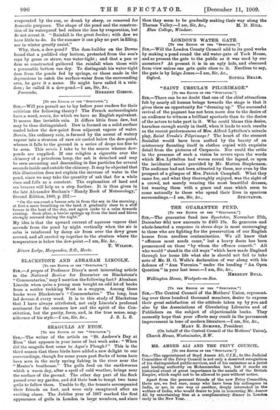[To THE EDITOR OF TEM " SPECTATOR." J SIR, — Will you
permit me to lay before your readers for their criticism the following theory P The French meteorologists have a word, serein, for which we have no English equivalent.
It means fine invisible rain. It differs little from dew, but may be thus distinguished. Dew is formed on a solid surface cooled below the dew-point from adjacent vapour of water. Serein, like ordinary rain, is formed by the ascent of watery vapour into a stratum of rare air cooled below the dew-point, whence it falls to the ground in a series of drops too fine to be seen. This serein I take to be the source whence dew- ponds are supplied. If one relights a cigarette over the chimney of a petroleum lamp, the ash is detached and may
be seen ascending and descending in fine particles for several seconds inside and outside the chimney. It may be objected that this illustration does not explain the increase of water in the pond, since we may take the quantity of ash that for a while rises and falls as a constant. The explanation of land and sea breezes will help us a step further. It is thus given in the late Alexander Buchan's "Handy Book of Meteorology," Second Edition, 1868, p. 212 :—
" On the sea-coast a breeze sets in from the sea in the morning ; at first a mere breathing on the land, it gradually rises to a stiff breeze in the heat of the day, and again sinks to a calm towards evening. Soon after, a breeze springs up from the land and blows strongly seaward during the night.'
My idea is that the upward current of aqueous vapour that ascends from the pond by night vertically when the air is calm is reinforced by damp air from over the dewy grass around, and all carried up together to the stratum where the temperature is below the dew-point.-1 am, Sir, &c., T. WiLsox.
Rivers Lodge, Harpenden, 5.0., Herts.
























































 Previous page
Previous page